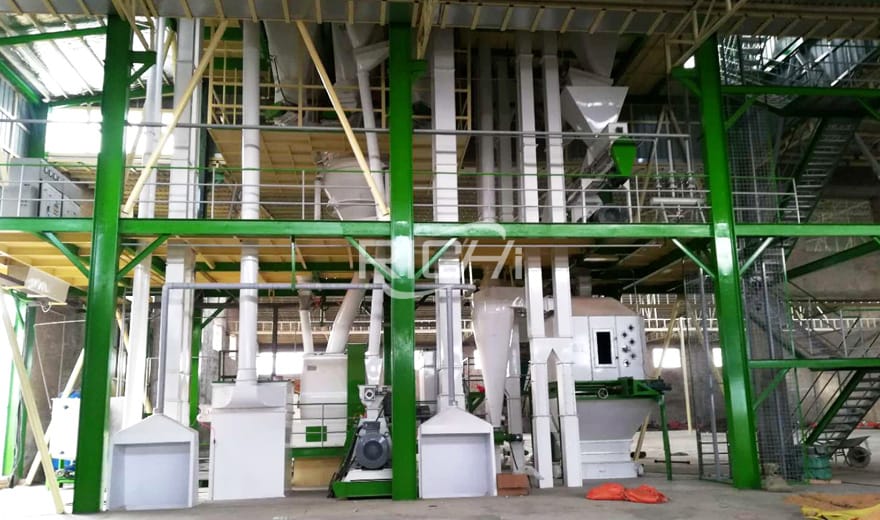Quality control rules for animal feed production process
1. The animal feed production workers can pick up the raw materials from the storage place with the picking list. The material requisition must be clear, stating the specific name, manufacturer and quantity of the raw materials received. Check whether the label and the packaging bag are consistent, and the quality controller supervises and inspects.
2. The batching personnel must check, calibrate and adjust the balance of the micro batching scale every day.
3. For trace elements, vitamins, medicines and other trace raw materials, the ingredients personnel must strictly follow the formula to prepare. Check whether the raw materials are consistent with the formula before weighing. The abnormal raw materials found in the weighing should be reported to the production supervisor and quality control staff immediately, and the use should be stopped.\

4. After each raw material is weighed, it should be marked on the formula table immediately to distinguish it from the raw materials that have not been weighed. And record its manufacturer, production batch number, raw material number, etc. Make the use of raw materials traceable.
5. After weighing the trace additives, the bag should be covered or tied tightly.
6. The feeder should check the name and check the total weight before picking up small materials. Feed materials according to the instructions of the central controller.
7. The bulk raw materials entering the warehouse should be fed according to the instructions of the central controller. During the feeding process, the raw materials found to be damp, fast, or mildewed should be stopped immediately and reported to the supervisor and quality control.
8. Regularly carry out the determination of mixing uniformity to determine the best mixing time to ensure that the coefficient of variation is not higher than 7%.
9. When feeding materials, half of the diluent or carrier must be added first, followed by the addition of trace components, and the order of feeding materials must not be reversed.
10. The mixing amount should not be less than 60% of the design maximum capacity, nor should it exceed 80% of the maximum capacity, otherwise the uniformity will be affected.
11. After each batch is mixed, the unloading should be clean and thorough. There should be no residue in the animal feed mixer. The yield should be 98% to 100%. If it exceeds this range, the reason should be explained and reported to the supervisor.
12. The animal feed making raw materials in the batching warehouse should be used up on the same day as possible, especially the trace elements in the upper warehouse.
13. The receiver should check, proofread and debug the packing scale before receiving the material, and check the accuracy of the packing scale. Determine the tare weight of the package and adjust the packing scale to the correct net or gross weight. Check whether the packaging bag, label and product are consistent.
When receiving materials, pay close attention to the appearance, color, particle size, and odor of the received product at all times to see if there is any debris. If there is any abnormality in the product sensory, report to the production supervisor and quality control in time. The first two packages of each batch of finished products and the final package that is not enough for the whole package are returned to the machine.
14. Each shift shall check the weight of finished products not less than three times and not less than 10 bags each time. The standard package should be: net weight + bag weight. Those with an error of more than ±50 grams are not allowed to leave the factory, and the number of packages with an error within ±50 grams Not less than 90%.
15. When sealing, the sewing thread should be straight, and there should be no broken threads, jumpers, loose sealing, etc., and the tape seal should be neat and beautiful, and no sewing thread should be exposed.
16. When changing varieties, especially the raw materials containing medicines, it must be cleaned with a carrier, and the conveying equipment must be cleaned at the same time. Carriers used for cleaning can be used in production at 0.5% added amount.
17. The sanitation and clean-up of the production area should be maintained at a high level. All equipment such as weighing pans, feeding ports, pre-mixing scales, etc. should be kept clean to prevent trace raw materials from being left behind. Operators must wear anti-virus masks.
18. The quality control personnel conduct quality supervision and inspection of the entire process to prevent quality accidents. Unscheduled inspection of the weight; planned inspection of finished products and quality analysis.
If you want to built one complete pellet production line in your country, pls send the inquiry to us. We will customized design according to your requirement.



